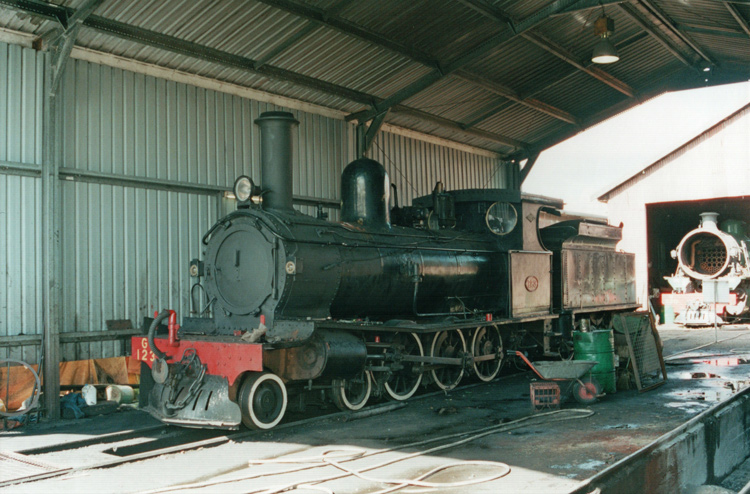|
G 123 represents one of the more
significant locomotive types used by the Western Australian Government
Railways (WAGR). The G-class were a versatile locomotive suitable for many
roles, based on a Beyer-Peacock & Co design evolved from the earlier
A-class 2-6-0 and becoming a de-facto standard for Australian narrow-gauge
operators, with similar locos operated by the South Australian Railways
(Y-class), Tasmanian Government Railways (C-class) and numerous private
operators including the Silverton Tramway, NSW (Y-class), the Chillagoe Mining
& Railway Co, Queensland and various timber concerns in several states.
The G-class appeared when the WAGR rail network was expanding rapidly, and
indeed the first locomotive was ex-contactor’s locomotive G 17 constructed in
1885 and which came into WAGR stock in 1889, while newly-built WAGR units
followed from 1893 onwards. Some newly delivered G-class were quickly sold
to contractors to assist in rail construction activities (including
preserved G 111 / G 71), while others
were ordered new by railway contractors and later came into WAGR ownership.
The initial seven G-class locos came from Beyer Peacock & Co,
Manchester but later examples came from Scottish builders Neilson & Co
and Dubs & Co, while many others were supplied by South Australian
manufacturer James Martin & Co. (It would be interesting to know what
commercial negotiations and license agreement with Beyer Peacock & Co
applied to machines built by these other companies.)
The initial WAGR G-class locos had a 2-6-0
wheel arrangement, like the earlier A-class, but were found to have some
issues in passenger work. The 4-6-0 wheel arrangement achieved worldwide
success in passenger duties, with the leading 4-wheel bogie helping to
guide the locomotive though curves and point work at the higher speeds
required in passenger traffic, and accordingly later G-class members were
built as 4-6-0 versions of the classic Beyer Peacock & Co design. I
have come across various accounts of the total number of G-class members –
some confusion is perhaps to be expected given the many acquisitions and
sales over the years – but the authorative work by Adrian Gunzburg ‘A
History of WAGR Steam Locomotives’ provides an account of each WAGR example,
totalling 73 locos comprising 49 of 2-6-0 version and 24 of the 4-6-0
version. Preserved loco G 123 is one of the later 4-6-0 version, being
introduced to traffic on Christmas Day 1897.
The G-class were inevitably superseded in
mixed-traffic duties by more modern and powerful steam locomotive types as
the decades passed, but some but found niche roles on branch lines and
jetty shunting. Following WAGR retirement, many were sold to private timber
and firewood supply operations. The versatility and ruggedness of the
design was again proven when a number of WAGR examples were sent to the
North Australia Railway at Darwin during World War 2, some later returning
to Western Australia.
G 123 was one of the final few G-class in
revenue service when serving as a jetty shunter at Bunbury by 1968.
Together with 2-6-0 sister G 233 it was retained and overhauled for the
‘Leschenault Lady’ vintage train service at Bunbury and to my knowledge was
never withdrawn by the WAGR or successor Westrail. For tourist duties G 123
received the name ‘Koombana Queen’, while G 233 was named ‘Leschenault
Lady’. The pair subsequently worked the popular ‘Leschenault Lady’ vintage
train services around Bunbury over the following years, as illustrated
below.
In 1987, the Hotham Valley Railway leased G
123 from Westrail for their ‘Forest Ranger’ services from Dwellingup. The
loco received significant boiler repairs in 2003 and has since returned to
service.
A good history for
the WAGR G-class generally, and G 123 in particular, can be found on the
Hotham Valley Railway website:
https://www.hothamvalleyrailway.com.au/steam-locomotives
|
|



